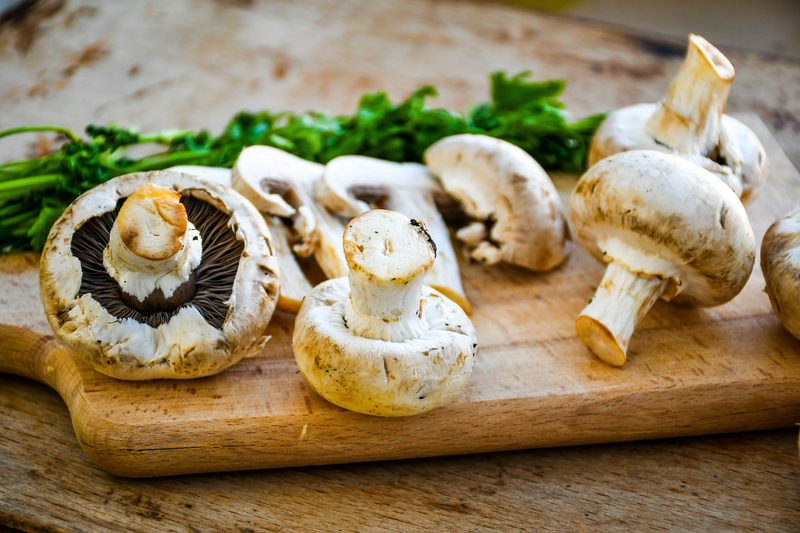Health Benefits of Mushrooms: See the Key Vitamins & Minerals

We all know fruits and vegetables are good for us, and most of us would classify mushrooms as vegetables, but we would be wrong. Mushrooms are scientifically classified as fungi. As mushrooms have no seeds, roots, or even leaves (and need no light to grow), they are not considered vegetables. The good news is that despite not technically being a vegetable, there are numerous health benefits of mushrooms because they’re chockful of key vitamins and nutrients associated with a reduced risk of many lifestyle-related health conditions.
The Health Benefits of Mushrooms
Mushrooms are naturally low in sodium, fat, cholesterol, and calories and have often been referred to as “functional foods.” Functional foods are foods that have a potentially positive effect on health beyond basic nutrition and may help promote optimal health and reduce the risk of disease. A familiar example of a functional food is oatmeal because it contains soluble fiber that may help lower cholesterol levels.
The nutritional breakdown of one cup of chopped or sliced raw white mushrooms are as follows:
- 15 calories
- 0 grams of fat
- 2.3 grams of carbohydrate
- 0.7 grams of fiber
- 1.4 grams of sugar
- 2.2 grams of protein
So, as you can see, there are so many health benefits of mushrooms. Plus, mushrooms can easily be included in any type of diet or meal plan including, but not limited to, paleo, Mediterranean, keto, low carb, low fat, high protein, or your own healthy well-balanced program.
The Edible Parts
There are a variety of different edible mushrooms, as well as some mushrooms known to have potentially harmful, even deadly, effects, so it may be good to cover some of the types of healthy mushrooms so you know what to look for. (And if you’re considering foraging for your own mushrooms, ensure you have an expert with you, so you don’t accidently pick a deadly variety.) But first, it may be helpful to identify the parts of the mushroom.
The four main parts of most mushrooms include:
- Cap (or hat): the umbrella-shaped top of the mushroom sitting on the stalk.
- Gills: the tubes, spines, and ridges found on the underside of the cap. These also release spores.
- Stalk: what the mushroom cap stands on.
- Mycelium: the roots that push the mushroom up for spore dispersal and your foraging.
The Health Breakdown of America’s 5 Most Popular Mushrooms
White Button Mushrooms

This is the most common type of mushroom and is therefore most likely to be used in most American dishes. This is largely due to their mild flavor and versatility. Studies have shown that eating white button mushrooms can have subtle effects on the microbial community, which may improve the regulation of blood sugar.
Cremini Mushrooms

These are similar in size and shape to the white button mushroom and are often interchanged in recipes; however, these are a little bit firmer and noticeably darker in color. Cremini mushrooms are actually small Portobello mushrooms and are often called “baby bellos.”
Portobello Mushrooms

These are a hearty, beefy-type pf mushroom often used in vegetarian dishes as a burger or beef replacement. On the other end of the spectrum, some people who are following a low-carbohydrate diet use Portobella’s as a bun for their sandwich or hamburger. Portobellas can also be consumed as a stand-alone dish as they are large enough to fit in the palm of your hand.
Shiitake Mushrooms

These have a light and woodsy aroma and taste and are easily identifiable as their stems are lighter in color in comparison to the caps. The tops curl over which resemble a tiny little umbrella. In Japanese, shiitake means “oak fungus,” which is where these mushrooms grow in the wild.
Porcini Mushrooms

These little guys are what you would expect to see if you were to open the pages of a fairytale and stumble into a magical forest. Known best for their earthy and nutty flavor, porcini mushrooms are somewhat of a gourmet delicacy. In Italian, porcini means “piglet,” and this variety is native to parts of Europe, Asia, and North America.
Health Benefits of Mushrooms: A Recap
The bottom line is that by eating more whole, unprocessed foods, including a variety of mushrooms, you may decrease the risk of obesity along with diabetes, heart disease, and even mortality. In addition, you may also be promoting a healthier complexion and hair, increased energy, and overall lower weight. So, no matter which edible mushroom you choose, you’ll be doing your body good.





